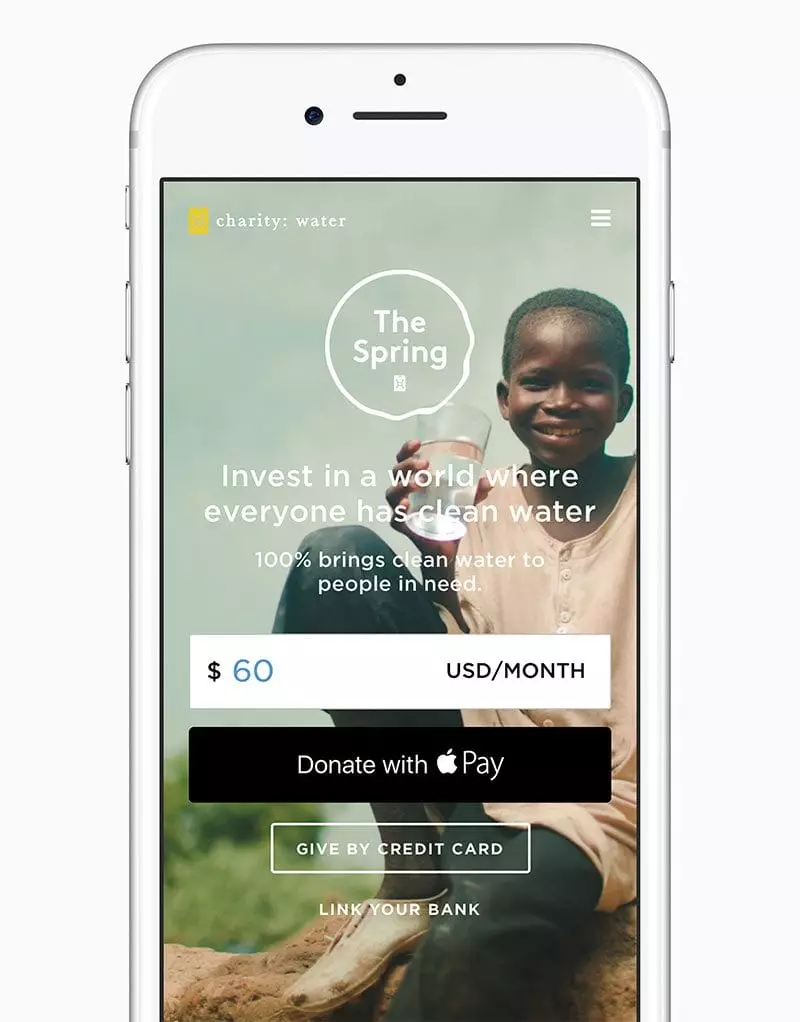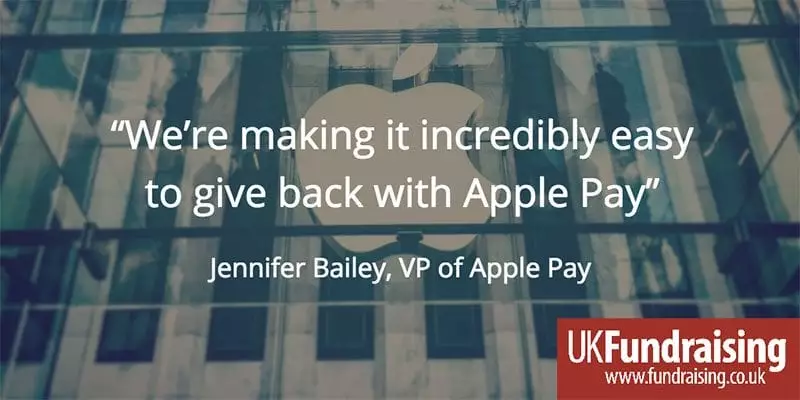Apple Pay extended to handle donations to US nonprofits
US nonprofits can now receive donations via Apple Pay, Apple’s mobile payment and digital wallet service. Instant donations can be made in this way to 19 organisations, with more due to accept it soon.
Apple Pay offers a secure way to donate to a nonprofit with just one touch. It is similar to contactless payments but with the addition of two-factor authentication for security.
It makes the giving process faster and easier by removing the need to enter billing and contact information on web forms.
It can be used on a compatible iOS device or on the web with Safari through macOS Sierra.

Charity: water accepts monthly gifts to its regular giving programme via Apple Pay.
Jennifer Bailey, Apple’s vice president of Apple Pay, explained:
“Websites and apps tell us they see twice as many people actually completing a purchase with Apple Pay than with other payment methods. We think offering such a simple and secure way to support the incredible work nonprofits do will have a significant impact on the communities they serve.”
Apple Pay was announced in September 2014 and initially available only to merchants in the USA. It has been expanded internationally since then, with payments being handled in the UK for the first time in July 2015.
Advertisement
Christmas giving
The extension to nonprofits comes at an opportune time, as US nonprofits gear up for the Christmas season of giving and the year-end campaigns that typically generate major spikes in giving.
Nonprofits have had to wait behind for-profit merchants for Apple payment systems before. Apple had a policy of not allowing developers to add ‘donate’ functionality to apps, including in-app payments, in its iTunes app store. Aware of the missed opportunity for charities, nonprofit staff and others triggered a petition in 2010, asking the company to change.
Now developers will be able to integrate Apple Pay directly within nonprofits’ apps, avoiding the need to direct people to give outside the app on the web or via SMS.
First nonprofits to accept Apple Pay donations
The first US nonprofits to accept donations by Apple Pay are:
- American Red Cross
- American Heart Association
- charity: water
- Children’s Miracle Network Hospitals
- COPD Foundation
- Crohn’s & Colitis Foundation of America (CCFA)
- Doctors without Borders
- Feeding America
- GlobalGiving
- International Rescue Committee
- (RED)
- St. Jude Children’s Research Hospital
- Save the Children
- The Nature Conservancy
- The Water Project
- UNICEF
- WNET
- World Vision
- WWF (World Wildlife Fund)
They will be followed by:
- American Cancer Society
- CARE
- DonorsChoose.org
- PBS and its local stations
- United Way
charity: water and Apple Pay
“At charity: water, we’re always looking for new ways to make funding clean water projects easier than ever. We’re thrilled to be one of the first charities that supports donations through Apple Pay.“663 million people around the world live without clean drinking water, but solutions are readily available and clean water transforms lives and communities. By integrating Apple Pay and making giving effortless – whether someone’s making an end of year donation or joining our new monthly giving program, The Spring – we hope to impact more lives than ever before.”
Using Apple Pay
“Each charity needs to make a judgement about the benefits of additional donations that they might turn away versus the disruption and confusion that introducing a new payment mechanism will add.“If Apple Pay is to be seen as purely substitutional for existing payment methods then how does getting involved in Apple Pay further any charity’s objectives? Apple Pay could in the long run be a game changer, but its short term impact will only be significant to the sector if it can be used to solve particular problems that fundraisers face.“Charities should be looking to explore using Apple Pay to open up cost effectively new giving propositions (e.g. unattended) or make existing ones more cost effective (e.g. street fundraising) or tapping into particular donor segments (e.g. elite high rollers).”
- When will UK charities be able to accept donations via Apple Pay? UK Fundraising will report.





